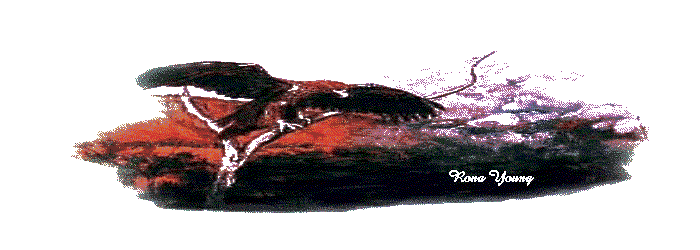


Archaeologist and Historian.
Introduction. |
Results. | D. Abraded and pecked ‘ritual’ motifs. | Conclusions. |
| Field Approach. | A. Bradshaw | E. Red ochre infill motifs. | Discussion. |
| Aims. | B. Zgomatauras | F. Red ochre outline motifs. | Recommendations. |
| C. Cupules. | G. Off-white ochre infill motifs. | References. |
| Fig 1. | View facing north from the general area of the rock art sites. | Fig 6. | Stylised Bradshaw figure. | 10a. | A second rock face showing pecked areas. |
| Fig 2. | Small ‘Sash’ Bradshaw figure. | Fig 7. | A red ochre painting of ‘Zygomatauras? | Fig 11. | Red ochre infill long armed anthropomorphic ‘ceremonial’? figure. |
| Fig 3. | Large 1 m ‘Sash’ Bradshaw figure. | Fig 8. | Ziggy? | Fig 12. | Single red infill anthropomorphic figure. |
| Fig 4. | Classic ‘Tassel’ Bradshaw figure. | Fig 9. | A pecked ‘ritual’ or ceremonial site? | Fig 13 & 13a. | Red ochre outline motifs. |
| Fig 5. | ‘Dynamic’ Bradshaw figure. | Fig 10 | A second rock face showing pecked areas. | Fig 14. | Off white infill ochre motif ‘map of country’. |
In April 2001, I was part of a research team approached by Bruce and Robyn Ellison, owners of Faraway Bay, to undertake a survey of the area around their camp. The main objective of this research was to evaluate the cultural and environmental value of their property. Their request came from a concern that a barge landing site proposed by Striker Resources, a diamond mining company, would impact on their tourist facility. A second concern was that their water was being piped from a creek that was thought to have significant paintings, and that this was of concern to descendants of traditional owners for the area.
The research team in April, consisted of several people with varying areas of expertise. Ju Ju Wilson, a descendant of the area through her paternal grandfather, and a member of the Mirriuwong language group, with the author and Dr Jim Kohen from Macquarie University, Sydney undertook the cultural and archaeological assessment. Other members of the team undertook vegetation analysis, zoology and environmental accounting. The main areas of investigation were:
The creek from which water is piped, and the ridge running west along side the creek.
The results of these surveys are the subject of a combined report produced for the Ellisons on the 6 th May 2001.
Early in September 2001, I was again approached by the Ellisons and asked if I would be interested in speaking with Delores ‘Dolly’ Cheinmora one of the Aboriginal descendants of the area. In a previous visit to Faraway Bay (organised by the Kimberley Land Council and the Ellisons). Dolly, a member of the Kwini Language Group, had expressed that she would like Robyn to hear her ‘stories’ of the area around Faraway Bay. This entailed the Ellisons organising a plane and time to visit Kalumburu. This was finally arranged for the 11 th of September.
A visiting anthropologist Janelle White agreed to accompany us to Kalumburu to undertake the actual recordings. Her report is attached to this document. It was also agreed that I would undertake a second and thorough archaeological assessment of the rock art sites above the Faraway Bay waterline. As Ju Ju Wilson, part of the first research team was unable to come, she had also asked me to take more photographs so she could show them to her grandmothers. Two days were set aside on the 10 tth and 11 th of September to undertake the survey and the interview with Dolly. This report is a response to that survey and an overview of the interview with Dolly. .The attached report by Janelle White is a transcript of that same interview.
The four sites located during the earlier survey were re photographed and recorded. An additional area, (an extension to the main rock shelter) was found to have painted motifs and large areas of pecking. Difficult to get to and located on a fairly precipitous ledge, this area of Aboriginal activity had been missed during the earlier survey. No other sites were found.
In order to achieve the best results for a later analysis of the photographic images of the rock art, photographs were taken using three different speeds. Janelle, also an amateur photographer used ASA 60. This film produced the best clarity of detail.
Janelle and I were assisted by Bruce and Robyn Ellison and our pilot, Peter Weiss from Alligator Airways. Peter also an experienced photographer, assisted with the photography. This was Robyn's first visit to these sites. Bruce had discovered the sites in the first year of their lease but had not been back until the earlier archaeological survey undertaken in April.
Care was taken to record all discernible superimposed layers of rock art as well as an assessment of the style of painting, techniques used, preservation status of the paintings, variations in motifs, positioning and location details and any other information which might provide further insight into Aboriginal activity in this area.
Using the above method of recording the author has found it is possible to determine change in the perception of Aboriginal use of rock art sites over time. It is also possible to define apparent sequences or themes within various layers of rock art. A relative time frame in which the last sequence of painting may have taken place can sometimes be discerned within the stylistic changes that differentiate the various rock art sequences. The presence of painted motifs depicting animals long extinct, and using dated rock art examples from other areas can also assist in providing a relative time frame of Aboriginal occupation.
While it is difficult, without scientifically dated sites to determine an ‘exact’ depth of time of Aboriginal occupation of an area, it is possible to define if there was change both over time and in the perception of how the site may have been used by Aboriginal people.
The September 2001 archaeological assessment of the rock art sites located above the Faraway Bay creek had several aims.
As described in the previous archaeological report for this area, all sites were located high up on the ridge, well away from the water line (see fig 1). Access to the water from these sites involves a fairly precipitous sixty odd metre climb over fallen boulders. The water pipe to the Ellisons camp is in excess of a hundred metres further down the creek.
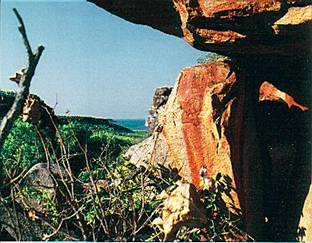
Fig 1.
With the exception of one rock overhang which also contained two quite separate areas of paintings, none were suitable as camping locations for Aboriginal groups. Two were just rock outcrops located at the very top of the ridge, and only provided approximately one metre of rock surface for painting. The third contained only a narrow ledge, enough to paint from, before dropping sharply away to the creek below. Again this area was more a series of fallen boulders precariously ‘placed’ on a rocky outcrop. The largest rock overhang was divided into two areas by large fallen boulders. While there appears to be sufficient area for a small group to camp, albeit on a rocky surface, there is no evidence of lithic material or other archaeological information that would indicate use by Aboriginal people for the area other than brief visits to carry out their painting activities. All the sites are within a 100 metre radius, taking up a very small section of the area in general. A number of more suitable overhangs with good rock surface and room for camping were ignored by Aboriginal people visiting the area.
The immediate impression when you come into the sites is that the choice of location, its isolation, and the stylistic components of the painted and engraved motifs were made by Aboriginal people with a specific purpose in mind. Separate visits over time has been determined in one site with four clearly superimposed layers of rock art sequences. There is no evidence of any repainting occurring in the last phase of rock art, and if there had been any repainting this evidence is no longer clear. Three of the sites indicate only a single phase of painting, with no evidence of any repainting over time. The remaining site indicates there may have been several periods of Aboriginal activity, with the presence of extensive areas of ‘pecking’ over the rock surface. The intensity and extensiveness of this pecking suggests this activity may have occurred on several occasions and was for very specific ‘ceremonial’ activities. Very faint red ochre painted animal motifs and ‘maps of country’ are also present in this same site, and appear to relate to one of the earlier sequence of rock art identified in the largest overhang.
The choice of rock motifs however, clearly indicate that over time this area has changed in either perception of use of the area by Aboriginal people, or that the change in style, motifs and technique also suggest that the area was visited by different cultural groups over time.
It is also very clear from the archaeological evidence that these sites are very old, and have been visited over thousands of years by Aboriginal people. There is also evidence that these visits were not visited often with large gaps in time when the sites appear not to have been visited at all. Equally clear from the evidence is that the sites have not been visited by Aboriginal people for traditional purposes since at least initial European contact in the area
The rock art in the Faraway Bay Creek sites has a number of distinctive sequences of stylistic changes in the motifs and technique through time. The following overview of the archaeological evidence will examine each of these changes.
The Faraway Bay Creek sites are dominated by the artistically and technologically beautiful Bradshaw anthropomorphic type figures ranging from 15 cm to two large figures approximately 1 m high (see fig 2 & 3).
Recent dating by amateur archaeologist and professional photographer Graham Walsh, indicates that the Classic Bradshaw paintings are at least 18,000 years old and disappeared around the end of the Pleistocene, some 10,000 years ago (2000:Bradshaw Art of the Kimberley).
While several stylistic variations of the Bradshaw paintings are present in three of the sites, all indicate they belong to a very early phase of the Bradshaw period of painting.
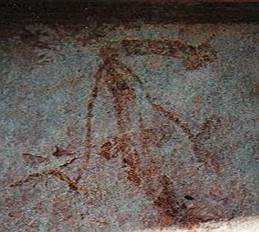
Fig 2.
There is no evidence of surface ochre remaining, with all examples now only represented as a faint ‘stain’ on the rock surface.
Of particular archaeological interest is the evidence of three quite different Bradshaw variations represented in four of the sites, with the main rock shelter showing three stylistic variations. This suggests that these sites may have been used at different points of time by the same Aboriginal cultural group at least until around ten thousand years ago.
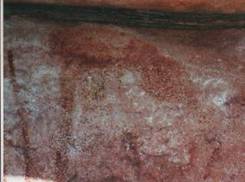
Fig 3.
Using the Walsh classification system, the Bradshaw figures represent a stylistic change through time, possibly over thousands of years (2000:135-167) ranging from figures representing the earliest Classic Tassel and Sash highly decorated figures to the Bradshaw ‘dynamic’ and later ‘stylised’ figure’s (see figs 4, 5 & 6).
If Walsh is correct in his dating, and of his classification of stylistic changes within this sequence of rock art, the Bradshaw paintings in these sites indicate a use of this area by Aboriginal people in excess of ten thousand years ago, and probably over a period of several thousand years. However the use of this area by the painters of the Bradshaw art sequence appear to have disappeared around the end of the Pleistocene, that is. around ten thousand years ago.
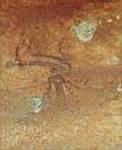
Fig 4.
The consistency of the highly sophisticated technique of painting required for the application of such motifs, irrespective of the progressive change in style, supports the hypothesis that the ‘Bradshaw’ art was carried out by the same cultural group. However, it also indicates that there was some change in the perception of how the sites were used by the aboriginal artists responsible for the Bradshaw paintings.
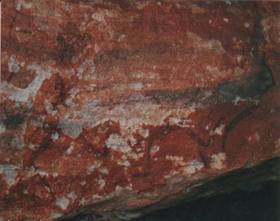
Fig 5.
Many of the "Bradshaw" style figures have been destroyed, and others partly obliterated by pecking and abrading, a phenomenon typical of this art form in other parts of the Kimberley. Where there is evidence of this deliberate attempt to ‘destroy’ the Bradshaw’ paintings, the areas of pecking and abrading show evidence of silica buildup, further indicating that this painting activity probably took place thousands of years ago.
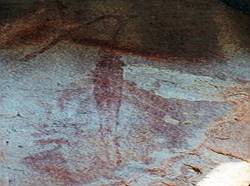
Fig 6.
The painting of a quadruped animal with a short tail and a long, almost giraffe-like neck and sloping rear end (see fig 7-8) may also provide some insight into how old some of the paintings in these sites might be. Given the suggested age of this animal motif as being perhaps 20,000 years old or even older (Kohen: pers com), and that it does not represent a dingo, thylacine of other animal which may have been present in the Kimberley region within the last ten thousand years, raises some interesting questions on how old some of the rock art in the Kimberley might be.
The painting in question resembles a Zygomatauras (ibid) and was known to have occurred in the Kimberley more than 20,000 years ago.
If the archaeological conclusion of this animal motif is correct this would place the site as being considerably older than the ‘Bradshaw’ painting phase. However, when comparing technique of painting, the colour of the ochre and the preservation status of the ‘Ziggy’ painting the archaeological conclusion would place this painting around the time of the dated ‘Walsh’ classic tassel ‘Bradshaw’ period of circa 18,000 years.
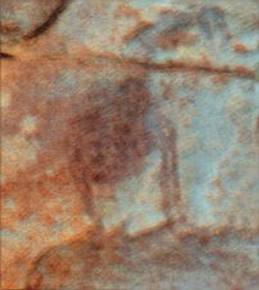
Fig 7.
This archaeological evidence suggests that Aboriginal people were using this area prior to 20,000 thousand years ago, and that ‘Ziggy’ was almost certainly known by the ‘Bradshaw’ painters. Whether ‘Ziggy’ was a prized food resource at the time or an animal of other significance will never be known. The fact that it is a ‘single’ painted motif of a Zygomatauras? amongst the classic tassel and sash ‘Bradshaw’ paintings indicates it may have had some cultural importance.

Fig 8.
Barely distinguisable is a large kangaroo motif just above and possibly underlying the Zygomatauras? painting. The ochre colour of the macropod? is a shade lighter in colour, or perhaps just more faded.
Cupule indentation found in the first section of the main rock painting site (main overhang) indicate some patterning, which suggests a ceremonial or ritual purpose, perhaps an increase ceremony for either food or some other resource (this patterning within the cupules was not discerned initially due to weathering processes). These cupules were isolated to only the first section of the main site.

Fig 9.
An unusual feature was the evidence of a ‘pecking’ process rather than the ‘desert’ influenced ‘abraded’ grinding process (see fig 9). The latter process has been recorded by the author as being a more common process in the general West Kimberley area.
Ochre splotches found above and around the cupules may indicate ritual purpose also. Archaeologically both indicate substantial age, but whether they emerge from the same activity in time is difficult to determine. The cupule’s had a fine silica buildup, and the paint splotches were little more than a very faint ‘stain’ on the rock surface. Graham Walsh indicates that cupule motifs are some of the oldest art forms in the world (ibid:200). If this is accurate these cupules (and perhaps the ochre splotches) may predate the ‘Bradshaw’ art sequence and the ‘Ziggy’ motif.
This site was not recorded during the first survey undertaken in May. Bruce Ellison stated he had been unaware of this site also. Located only 10 m north of the main overhang, and sitting precariously on a narrow ledge slightly lower than the rest of the sites, this unique site was quite startling in its visual impact. Several boulders had literally hundreds of thousands of pecked indentations (see fig 10 & 10a) with some areas of the rock surface so ‘pecked’ that they had merged into one and another.
 |
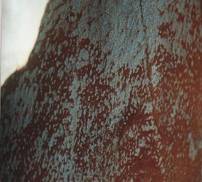 |
Fig 10. |
Fig 10a. |
This activity, like the cupule motifs, certainly indicates ceremonial or ritual activity of some sort, possibly an ‘increase’ ceremony for rain or a food resource etc.
Cupules and ‘cuts’ are more commonly observed for the ‘ritual’ of increase ceremony. The latter are often described as spear sharpening grooves, but many sites recorded by the author in the Kimberley hold thousands of these carefully aligned and placed ‘cuts’ or abraded grooves.
There is little evidence of a silica buildup. Or that the pecking was placed over the top of other painted motifs. The archaeological evidence indicates these ‘pecked’ ceremonial sites are relatively recent and probably occurred after the ‘Bradshaw’ and cupule sequences. However, evidence of very faint barely discernible red ochre outline kangaroo motifs and ‘country’ maps may be associated with the ‘ritual’ pecking. These are located on the ceiling of the large fallen boulder overlying the ‘pecked’ boulders. The preservation status of these very protected red ochre motifs, their style and technique indicate they belong to a period of painting well before European impact. Their relationship to the ‘pecked’ ritual site suggests this activity also relates to a period well before European impact.
The main site also contains up to three different stylistic variations of red ochre infill motifs other than those associated with the Bradshaw and Ziggy sequence of rock painting (see figs 11 to 12). These motifs range from animals and their footprints to two quite different anthropomorphic single figures. The colour of the ochre pigment also varies, ranging from the use of a strong red to the almost dark purplish pigment observed in some of the Bradshaw paintings.
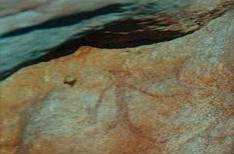
Fig 11.
The red ochre infill motifs, unless specifically superimposed over one another are difficult to interpret whether they belong to the same period or phase of painting. This site presents a similar problem. For this reason I have categorised these paintings into a single sequence, however they are interpreted as being painted at different periods during this sequence. They may well represent periods of painting that could be untold years apart.
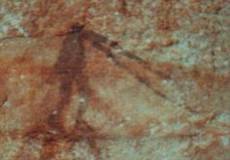
Fig 12.
Without exception all examples of this style are represented only as faint ochre stains on the rock surface, even in the most protected areas of the rock overhang.
The preservation status, style and technique, and the presence of other motifs superimposed over some of the motifs belonging to this sequence indicate they belong to a very early period of painting by Aboriginal people.
The red ochre single outline motifs range from simple but beautifully applied paintings of animal motifs to more complex ‘maps of country’ and other line drawings (see fig 13 & 13a). They are quite clearly superimposed over the Bradshaw period of painting, and also appear to overlay the red infill phase, although this was not quite as clear.
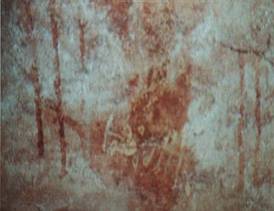
Fig 13
The archaeological evidence suggests this is a relatively late period of painting style for this area, however, the ochre in all examples is only a stain on the rock surface, suggesting they too are of considerable age.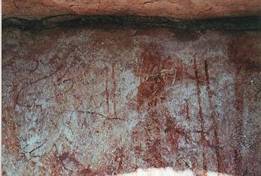
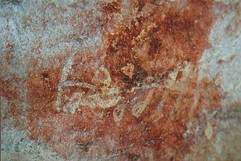
Fig 14.
The lack of the fine white ochre outline animal and anthropomorphic motifs suggest there was a interim period of Aboriginal inactivity in this immediate area for sometime prior to European contact. This phase of rock painting belonging to the last sequence of rock art in large parts of the Kimberley has been identified by the author.
There is evidence of only one example of an offwhite heavily applied ochre infill motif generally associated with the Aboriginal period of rock art painting around the time of European contact (see fig 14). The motif, interestingly, is painted over a much larger and earlier red ochre ‘map of country’ (see fig 13). Located in the main site, this motif appears to represent a ‘map of country’. This is the only ochre painted motif in the site which still has detectable ochre attached to the rock surface.
The archaeological analysis of the rock art motifs from five sites located above the Faraway Bay creek provided a number of interesting conclusions.
The rock art sites located above the Faraway Bay creek line indicate they have probably been used by Aboriginal people for at least twenty thousand years. The sites do not appear to have been visited on a regular basis by Aboriginal people, and there is evidence that there may have been gaps of hundreds if not thousands of years when the sites were not visited at all.
There is little evidence in the archaeological information that indicates the sites were used for family or hunting group activity. The evident time lapse in between painting, the style of painting, choice of painted motifs and the presence of cupules and deliberately pecked areas suggests they were probably visited by Aboriginal people for ritual or ceremonial activity. It is also clear that the perception of how and why Aboriginal people came into this area changed over time. The evidence also suggests that cultural ideas changed and/or the area was being visited by different Aboriginal groups through time. The last visit by Aboriginal people appears to be around the time of initial European contact. Whatever was behind this visit the only archaeological evidence visible is one single motif which appears to represent a ‘map of country’.
With the exception of this one single motif all the painted rock art and engraved and pecked motifs were applied a long time before European contact in the area. The archaeological evidence also suggests that the sites have not been visited since European contact by Aboriginal people for any traditional type activities.
Scott-Virtue et al. 2001. Faraway Bay Research Report. Kimberley Specialists publication. Kununurra.
Walsh, G. 2000. Bradshaw Art of the Kimberley. Takarakka Nowan Kas Publications. Queensland.